SUMMARY CMI
XTANDI®
Consumer Medicine Information (CMI) summary
The full CMI on the next page has more details. If you are worried about using this medicine, speak to your doctor or pharmacist.
1. Why am I using XTANDI?
XTANDI contains the active ingredient enzalutamide. XTANDI is used to treat adult men with prostate cancer that no longer responds to hormone therapy or surgical treatment to lower testosterone, or that has spread to other parts of the body and is considered "hormone sensitive". XTANDI is also used to treat adult men with prostate cancer that has not spread to other parts of the body and is considered "hormone sensitive", and who are at high risk of cancer spreading to other parts of the body.
For more information, see Section 1. Why am I using XTANDI? in the full CMI.
2. What should I know before I use XTANDI?
Do not use if you have ever had an allergic reaction to XTANDI or any of the ingredients listed at the end of the CMI.
Talk to your doctor if you have any other medical conditions, take any other medicines, or are pregnant or plan to become pregnant, or are breastfeeding. XTANDI is not for use in women.
For more information, see Section 2. What should I know before I use XTANDI? in the full CMI.
3. What if I am taking other medicines?
Some medicines may interfere with XTANDI and affect how it works.
A list of these medicines is in Section 3. What if I am taking other medicines? in the full CMI.
4. How do I use XTANDI?
- The usual dose is four 40 mg capsules taken at the same time once a day. Your doctor may reduce your dose depending on your medical conditions.
More instructions can be found in Section 4. How do I use XTANDI? in the full CMI.
5. What should I know while using XTANDI?
| Things you should do |
|
| Things you should not do |
|
| Driving or using machines |
|
| Looking after your medicine |
|
For more information, see Section 5. What should I know while using XTANDI? in the full CMI.
6. Are there any side effects?
There are a number of side effects associated with this medicine. It is important to be aware of them so that you can identify any symptoms if they occur (see the full CMI for more details). The most common and serious side effects are breathlessness, chest pain, fall, broken bones, cancer as a result of previous treatment with radiation or chemotherapy.
For more information, including what to do if you have any side effects, see Section 6. Are there any side effects? in the full CMI.
FULL CMI
XTANDI® (ex-TAN-dee)
Active ingredient(s): enzalutamide (enza-LOOT-ah-mide)
Consumer Medicine Information (CMI)
This leaflet provides important information about using XTANDI. You should also speak to your doctor or pharmacist if you would like further information or if you have any concerns or questions about using XTANDI.
Where to find information in this leaflet:
1. Why am I using XTANDI?
2. What should I know before I use XTANDI?
3. What if I am taking other medicines?
4. How do I use XTANDI?
5. What should I know while using XTANDI?
6. Are there any side effects?
7. Product details
1. Why am I using XTANDI?
XTANDI contains the active ingredient enzalutamide.
XTANDI is an androgen receptor inhibitor.
XTANDI is used to treat adult men with prostate cancer that no longer responds to hormone therapy or surgical treatment to lower testosterone,
or
that has spread to other parts of the body and is considered "hormone sensitive",
or
that has not spread to other parts of the body and is considered "hormone sensitive", and who are at high risk of cancer spreading to other parts of the body.
This medicine works by blocking the activity of hormones called androgens (such as testosterone). By blocking androgens, XTANDI stops prostate cancer cells from growing and dividing.
2. What should I know before I use XTANDI?
Warnings
Do not use XTANDI if:
- you are allergic to enzalutamide, or any of the ingredients listed at the end of this leaflet.
- Always check the ingredients to make sure you can use this medicine.
- XTANDI is not for use in women.
Check with your doctor if you:
have any other medical conditions such as:
- a history of seizures
- a serious head injury or a history of head trauma
- a stroke
- a brain tumour, or cancer which has spread to the brain
- drink very large amounts of alcohol either regularly or from time to time
- are taking a medicine that can cause seizures or that increases risks for having seizures (see Section 3. What if I am taking other medicines?).
(In some of these situations you may have a higher risk of having a seizure.)
take any medicines for any other condition such as:
- heart or blood pressure problems
- kidney problems
- a partner who is pregnant or is planning to become pregnant.
During treatment, you may be at risk of developing certain side effects. It is important you understand these risks and how to monitor for them. See additional information under Section 6. Are there any side effects?
Pregnancy and breastfeeding
Check with your doctor if you are pregnant or intend to become pregnant.
Talk to your doctor if you are breastfeeding or intend to breastfeed.
This medicine may cause harm to the unborn child or potential loss of pregnancy if it is taken by women who are pregnant. It must not be taken by women who are pregnant, may become pregnant, or who are breast feeding.
This medicine could possibly have an effect on male fertility.
If you are having sex with a woman who can become pregnant, you must use a condom and another effective birth control method, during treatment and for 3 months after stopping treatment with this medicine. Men who are sexually active with a pregnant woman must use a condom during and for 3 months after stopping treatment with XTANDI to protect the unborn child.
Female caregivers see Section 4. How do I use XTANDI? for handling and use.
Talk with your doctor if you have questions about birth control. Your doctor can discuss with you the risks and benefits involved.
If you are not sure whether you should start taking this medicine, talk to your doctor.
3. What if I am taking other medicines?
Tell your doctor or pharmacist if you are taking any other medicines, including any medicines, vitamins or supplements that you buy without a prescription from your pharmacy, supermarket or health food shop.
When taken at the same time as XTANDI, these medicines may increase the risk of a seizure:
- certain medicines used to treat asthma and other respiratory diseases (e.g. aminophylline, theophylline)
- medicines used to treat certain psychiatric disorders such as depression and schizophrenia (e.g. clozapine, olanzapine, risperidone, ziprasidone, bupropion, lithium, chlorpromazine, thioridazine, amitriptyline, desipramine, doxepin, imipramine, mirtazapine)
- certain medicines for the treatment of pain (e.g. pethidine).
Some medicines and XTANDI may interfere with each other. These include certain medicines used to:
- treat pain (e.g. fentanyl, tramadol, paracetamol)
- thin the blood, or to prevent blood clots (e.g. warfarin, clopidogrel)
- lower cholesterol (e.g. gemfibrozil, atorvastatin, simvastatin)
- treat cancer (e.g. cabazitaxel)
- treat epilepsy (e.g. carbamazepine, clonazepam, phenytoin, primidone, valproic acid)
- treat certain psychiatric disorders such as severe anxiety or schizophrenia (e.g. diazepam, midazolam, haloperidol)
- treat sleep disorders (e.g. zolpidem)
- treat heart conditions or lower blood pressure (e.g. bisoprolol, digoxin, diltiazem, felodipine, nicardipine, nifedipine, propanolol, verapamil)
- treat serious disease related to inflammation (e.g. dexamethasone, prednisolone)
- lower your immunity (e.g. cyclosporin, tacrolimus)
- treat HIV infection (e.g. indinavir, ritonavir)
- treat bacterial infections (e.g. clarithromycin, doxycycline, rifampicin)
- treat thyroid disorders (e.g. levothyroxine)
- treat gout (e.g. colchicine)
- prevent heart conditions or strokes (dabigatran etexilate)
- treat reflux disease or peptic ulcers (e.g. omeprazole)
These medicines may be affected by XTANDI or may affect how well it works. You may need different amounts of your medicines, or you may need to take different medicines.
Your doctor and pharmacist have more information on medicines to be careful with or avoid while taking this medicine.
Some medicines may interfere with XTANDI and affect how it works.
Medicines that may increase the effect of XTANDI include:
- gemfibrozil
- itraconazole
Medicines that may reduce the effect of XTANDI include:
- rifampicin
Check with your doctor or pharmacist if you are not sure about what medicines, vitamins or supplements you are taking and if these affect XTANDI.
4. How do I use XTANDI?
Follow all directions given to you by your doctor or pharmacist carefully.
They may differ from the information contained in this leaflet.
If you do not understand the instructions on the box, ask your doctor or pharmacist for help.
How much to take
- The usual dose is four 40 mg capsules taken at the same time once a day. Your doctor may reduce your dose depending on your medical conditions.
- Reduced dose:
If you are taking a reduced dose of XTANDI, you may use the remaining capsules in the open dose compartment for your next scheduled dose, provided that the capsules have been otherwise stored under the conditions described below (see Looking after your medicine) - Follow the instructions provided and use XTANDI until your doctor tells you to stop.
How to take it
- Swallow the capsules whole with a full glass of water.
Do not chew, dissolve or open the capsules before swallowing. - You can take XTANDI with or without food.
- XTANDI should not be handled by persons other than the patient and his caregivers. Women who are or may become pregnant should not handle damaged or opened enzalutamide capsules without protection, e.g., gloves.
When to take XTANDI
- XTANDI should be taken at about the same time each day. Taking it at the same time each day will have the best effect. It will also help you remember when to take it.
If you forget to use XTANDI
XTANDI should be used regularly at the same time each day. If you miss your dose at the usual time, take it as soon as you remember, and then go back to taking your medicine as you would normally.
If you forget to take XTANDI for the whole day, take your usual dose the following day.
If you forget to take XTANDI for more than one day, talk to your doctor immediately.
If it is almost time for your next dose, skip the dose you missed and take your next dose when you are meant to.
Do not take a double dose to make up for the dose you missed.
This may increase the chance of you getting an unwanted side effect.
If you are not sure what to do, ask your doctor or pharmacist.
If you have trouble remembering to take your medicine, ask your pharmacist for some hints.
If you use too much XTANDI
If you think that you have used too much XTANDI, you may need urgent medical attention.
You should immediately:
- phone the Poisons Information Centre
(by calling 13 11 26), or - contact your doctor, or
- go to the Emergency Department at your nearest hospital.
You should do this even if there are no signs of discomfort or poisoning.
You may need urgent medical attention.
You may be at increased risk of experiencing a seizure.
5. What should I know while using XTANDI?
Things you should do
If you are about to be started on any new medicine, remind your doctor and pharmacist that you are taking XTANDI.
If you are going to have surgery, tell the surgeon or anaesthetist that you are taking this medicine.
Keep all of your doctor's appointments so that your progress can be checked.
Call your doctor straight away if:
- your partner becomes pregnant while taking this medicine.
Remind any doctor, dentist or pharmacist you visit that you are using XTANDI.
Things you should not do
- Do not take XTANDI to treat any other complaints unless your doctor tells you to.
- Do not give your medicine to anyone else, even if they have the same condition as you.
- Do not stop taking your medicine or alter the dosage without checking with your doctor.
Driving or using machines
Be careful before you drive or use any machines or tools until you know how XTANDI affects you.
XTANDI may have a moderate influence on your ability to drive or use any tools or machinery. Seizures have been reported in patients taking XTANDI. If you are at higher risk of seizures, talk to your doctor.
Looking after your medicine
- Keep your capsules in the pack until it is time to take them.
- If you take the capsules out of the pack they may not keep as well.
- If you are taking a reduced dose of XTANDI, you may store the remaining capsules in the open dose compartment until the next dose, provided that the capsules have been otherwise stored under the conditions described below.
- Keep your capsules in the original packaging in a cool dry place where the temperature stays below 25°C.
- Do not take any capsule that is leaking, damaged, or shows signs of tampering.
- A locked cupboard at least one-and-a-half metres above the ground is a good place to store medicines.
Follow the instructions in the carton on how to take care of your medicine properly.
Store it in a cool dry place away from moisture, heat or sunlight; for example, do not store it:
- in the bathroom or near a sink, or
- in the car or on window sills.
Keep it where young children cannot reach it.
When to discard your medicine
If your doctor tells you to stop taking this medicine or the expiry date has passed, ask your pharmacist what to do with any medicine that is left over.
Do not throw away any medicines via wastewater or household waste.
Getting rid of any unwanted medicine
If you no longer need to use this medicine or it is out of date, take it to any pharmacy for safe disposal.
Do not use this medicine after the expiry date.
6. Are there any side effects?
Tell your doctor or pharmacist as soon as possible if you do not feel well while you are taking XTANDI.
All medicines can have side effects. If you do experience any side effects, most of them are minor and temporary. However, some side effects may need medical attention.
See the information below and, if you need to, ask your doctor or pharmacist if you have any further questions about side effects.
Do not be alarmed by the following lists of side effects. You may not experience any of them.
Ask your doctor or pharmacist to answer any questions you may have.
Less serious side effects
| Less serious side effects | What to do |
| Speak to your doctor if you have any of these less serious side effects and they worry you. |
Serious side effects
| Serious side effects | What to do |
| Call your doctor straight away, or go straight to the Emergency Department at your nearest hospital if you notice any of these serious side effects. |
Tell your doctor or pharmacist if you notice anything else that may be making you feel unwell.
Other side effects not listed here may occur in some people.
Reporting side effects
After you have received medical advice for any side effects you experience, you can report side effects to the Therapeutic Goods Administration online at www.tga.gov.au/reporting-problems. By reporting side effects, you can help provide more information on the safety of this medicine.
Always make sure you speak to your doctor or pharmacist before you decide to stop taking any of your medicines.
7. Product details
This medicine is only available with a doctor's prescription.
What XTANDI contains
| Active ingredient (main ingredient) | enzalutamide |
| Other ingredients (inactive ingredients) | caprylocaproyl macrogolglycerides butylated hydroxyanisole butylated hydroxytoluene gelatin sorbitol sorbitan solution glycerol titanium dioxide purified water OPACODE WB monogramming ink NSP-78-17827 BLACK |
Do not take this medicine if you are allergic to any of these ingredients.
What XTANDI looks like
XTANDI capsules are white to off-white, oblong soft gelatin capsules with "ENZ" written on one side in black ink.
XTANDI is available in packs of 112 capsules (in 4 wallets of 28 capsules each).
(AUST R 210494)
Who distributes XTANDI
XTANDI is distributed in Australia by:
Astellas Pharma Australia Pty Ltd
Suite 2.01, 2 Banfield Road
Macquarie Park, NSW 2113
Medical Information:
1800 751 755
® = Registered Trademark
This leaflet was prepared in February 2025.
Published by MIMS April 2025

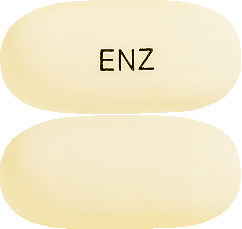

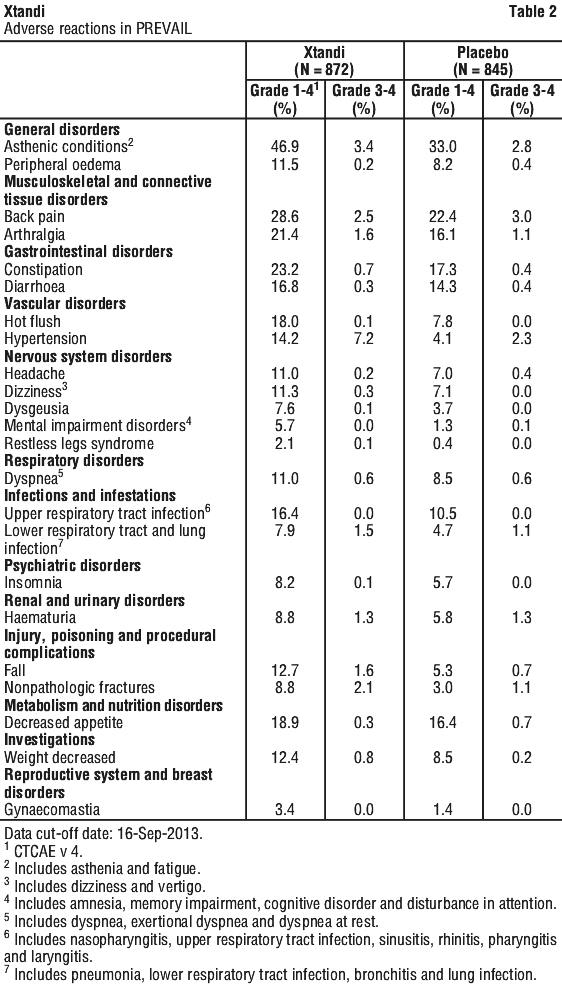




 Overall, deaths from adverse reactions during the total duration of treatment occurred in 6 patients (1.7%) receiving Xtandi plus a LHRH analogue, 8 patients (2.3%) receiving Xtandi as monotherapy, and 3 patients (0.8%) receiving placebo plus a LHRH analogue. The reason for death in ≥ 2 patients receiving Xtandi plus a LHRH analogue was infection (n = 2), and the reason for death in ≥ 2 patients receiving Xtandi as monotherapy was arterial thromboembolism (n = 2). Patients receiving placebo plus a LHRH analogue died from sepsis (n = 1), acute myeloid leukemia (n = 1), and myocardial ischaemia (n = 1).
Overall, deaths from adverse reactions during the total duration of treatment occurred in 6 patients (1.7%) receiving Xtandi plus a LHRH analogue, 8 patients (2.3%) receiving Xtandi as monotherapy, and 3 patients (0.8%) receiving placebo plus a LHRH analogue. The reason for death in ≥ 2 patients receiving Xtandi plus a LHRH analogue was infection (n = 2), and the reason for death in ≥ 2 patients receiving Xtandi as monotherapy was arterial thromboembolism (n = 2). Patients receiving placebo plus a LHRH analogue died from sepsis (n = 1), acute myeloid leukemia (n = 1), and myocardial ischaemia (n = 1).





 Xtandi as monotherapy also demonstrated a statistically significant 37% reduction in the risk of developing an MFS event as compared to placebo plus ADT [HR = 0.63 (95% CI: 0.46, 0.87) p = 0.0049]. The median time to an MFS event was not reached in either treatment arm).
Xtandi as monotherapy also demonstrated a statistically significant 37% reduction in the risk of developing an MFS event as compared to placebo plus ADT [HR = 0.63 (95% CI: 0.46, 0.87) p = 0.0049]. The median time to an MFS event was not reached in either treatment arm).

 The major efficacy outcome was supported by multiple secondary endpoints. A statistically significant 72% reduction in risk of initiation of a new antineoplastic therapy was demonstrated for patients in the Xtandi arm compared to patients in the placebo arm (HR = 0.28 [95% CI: 0.20, 0.40]; p < 0.0001). A statistically significant improvement of 19.3% in objective response rate (percentage of patients with complete or partial response in their soft tissue disease) was demonstrated with an Objective Response Rate (OSS) (calculated as percentage of patients with measurable disease at baseline who achieved a complete or partial response in their soft tissue disease) of 83.1% for patients in the Xtandi arm compared to 63.7% for patients in the placebo arm (95% CI: 10.4, 28.2; p < 0.0001). Time to First Symptomatic Skeletal Event (SSE) (time from randomisation to the occurrence of the first symptomatic skeletal event) was associated with a 48% reduction in the risk of a patient experiencing an SSE compared with patients in the placebo arm [HR = 0.52, 95% CI: 0.33, 0.80; nominal p = 0.0026].
The major efficacy outcome was supported by multiple secondary endpoints. A statistically significant 72% reduction in risk of initiation of a new antineoplastic therapy was demonstrated for patients in the Xtandi arm compared to patients in the placebo arm (HR = 0.28 [95% CI: 0.20, 0.40]; p < 0.0001). A statistically significant improvement of 19.3% in objective response rate (percentage of patients with complete or partial response in their soft tissue disease) was demonstrated with an Objective Response Rate (OSS) (calculated as percentage of patients with measurable disease at baseline who achieved a complete or partial response in their soft tissue disease) of 83.1% for patients in the Xtandi arm compared to 63.7% for patients in the placebo arm (95% CI: 10.4, 28.2; p < 0.0001). Time to First Symptomatic Skeletal Event (SSE) (time from randomisation to the occurrence of the first symptomatic skeletal event) was associated with a 48% reduction in the risk of a patient experiencing an SSE compared with patients in the placebo arm [HR = 0.52, 95% CI: 0.33, 0.80; nominal p = 0.0026].

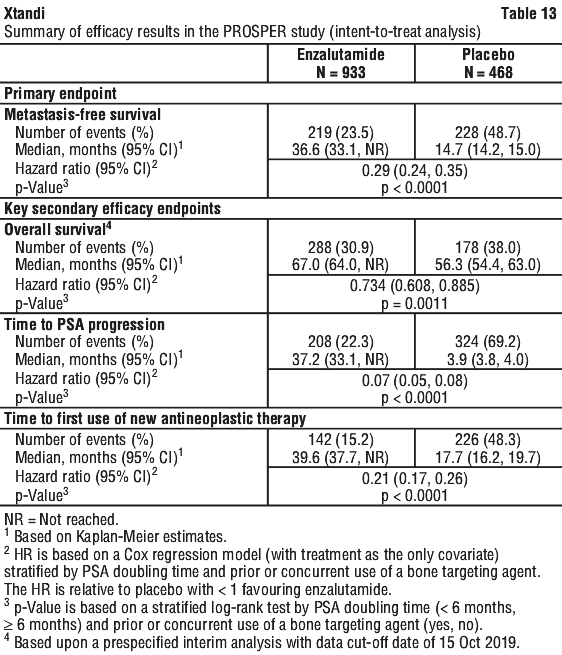
 At the final analysis for overall survival, conducted when 466 deaths were observed, a statistically significant improvement in overall survival was demonstrated in patients randomised to receive enzalutamide compared with patients randomised to receive placebo with a 26.6% reduction in risk of death [hazard ratio (HR) = 0.734, (95% CI: 0.608; 0.885), p = 0.0011]. The median follow-up time was 48.6 and 47.2 months for the enzalutamide and placebo groups, respectively. Thirty-three percent of enzalutamide-treated and 65% of placebo-treated patients received at least one subsequent antineoplastic therapy that may prolong overall survival. See Figure 9.
At the final analysis for overall survival, conducted when 466 deaths were observed, a statistically significant improvement in overall survival was demonstrated in patients randomised to receive enzalutamide compared with patients randomised to receive placebo with a 26.6% reduction in risk of death [hazard ratio (HR) = 0.734, (95% CI: 0.608; 0.885), p = 0.0011]. The median follow-up time was 48.6 and 47.2 months for the enzalutamide and placebo groups, respectively. Thirty-three percent of enzalutamide-treated and 65% of placebo-treated patients received at least one subsequent antineoplastic therapy that may prolong overall survival. See Figure 9. Enzalutamide demonstrated a statistically significant 93% reduction in the relative risk of PSA progression compared to placebo [HR = 0.07 (95% CI: 0.05, 0.08), p < 0.0001]. Median time to PSA progression was 37.2 months (95% CI: 33.1, NR) on the enzalutamide arm versus 3.9 months (95% CI: 3.8, 4.0) on the placebo arm.
Enzalutamide demonstrated a statistically significant 93% reduction in the relative risk of PSA progression compared to placebo [HR = 0.07 (95% CI: 0.05, 0.08), p < 0.0001]. Median time to PSA progression was 37.2 months (95% CI: 33.1, NR) on the enzalutamide arm versus 3.9 months (95% CI: 3.8, 4.0) on the placebo arm.


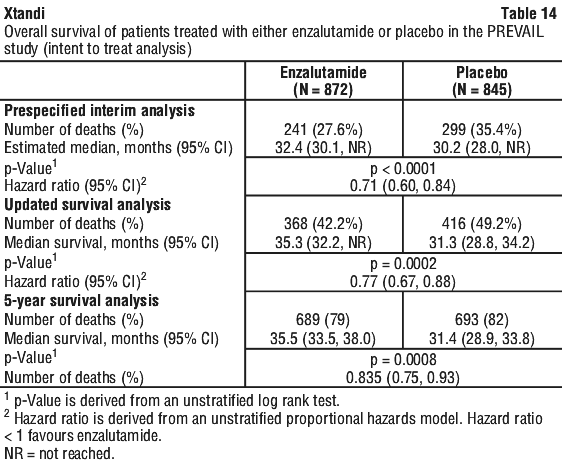

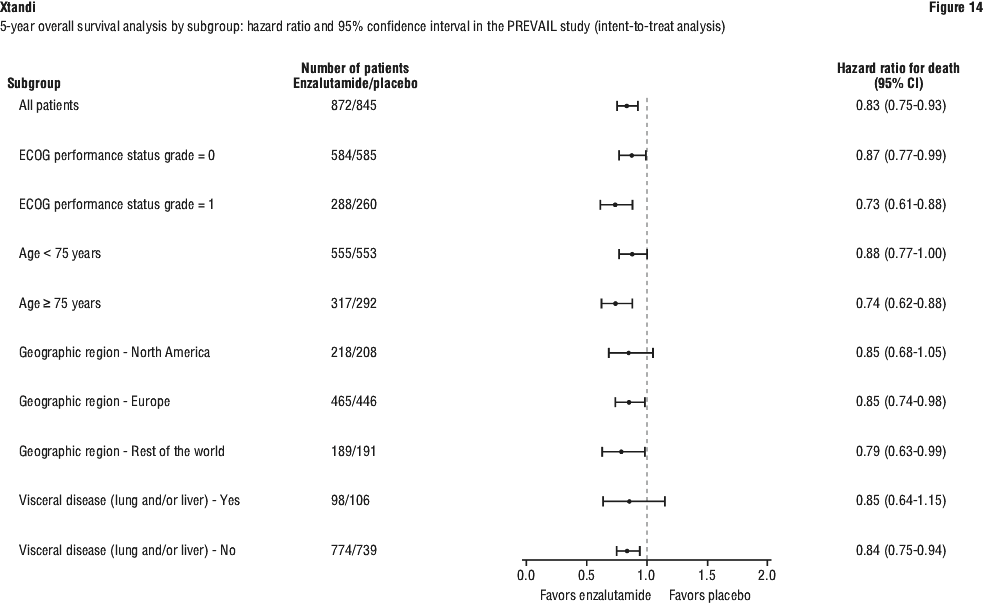 At the pre-specified rPFS analysis, a statistically significant improvement was demonstrated between the treatment groups with an 81.4% reduction in risk of radiographic progression or death [HR = 0.19 (95% CI: 0.15, 0.23), p < 0.0001]. One hundred and eighteen (14%) enzalutamide-treated patients and 321 (40%) of placebo-treated patients had an event. The median rPFS was not reached (95% CI: 13.8, not reached) in the enzalutamide-treated group and was 3.9 months (95% CI: 3.7, 5.4) in the placebo-treated group (see Figure 15). Consistent rPFS benefit was observed across all pre-specified patient subgroups (e.g. age, baseline ECOG performance, baseline PSA and LDH, Gleason score at diagnosis, and visceral disease at screening). A pre-specified follow-up rPFS analysis based on the investigator assessment of radiographic progression demonstrated a statistically significant improvement between the treatment groups with a 69.3% reduction in risk of radiographic progression or death [HR = 0.31 (95% CI: 0.27, 0.35), p < 0.0001]. The median rPFS was 19.7 months in the enzalutamide group and 5.4 months in the placebo group.
At the pre-specified rPFS analysis, a statistically significant improvement was demonstrated between the treatment groups with an 81.4% reduction in risk of radiographic progression or death [HR = 0.19 (95% CI: 0.15, 0.23), p < 0.0001]. One hundred and eighteen (14%) enzalutamide-treated patients and 321 (40%) of placebo-treated patients had an event. The median rPFS was not reached (95% CI: 13.8, not reached) in the enzalutamide-treated group and was 3.9 months (95% CI: 3.7, 5.4) in the placebo-treated group (see Figure 15). Consistent rPFS benefit was observed across all pre-specified patient subgroups (e.g. age, baseline ECOG performance, baseline PSA and LDH, Gleason score at diagnosis, and visceral disease at screening). A pre-specified follow-up rPFS analysis based on the investigator assessment of radiographic progression demonstrated a statistically significant improvement between the treatment groups with a 69.3% reduction in risk of radiographic progression or death [HR = 0.31 (95% CI: 0.27, 0.35), p < 0.0001]. The median rPFS was 19.7 months in the enzalutamide group and 5.4 months in the placebo group.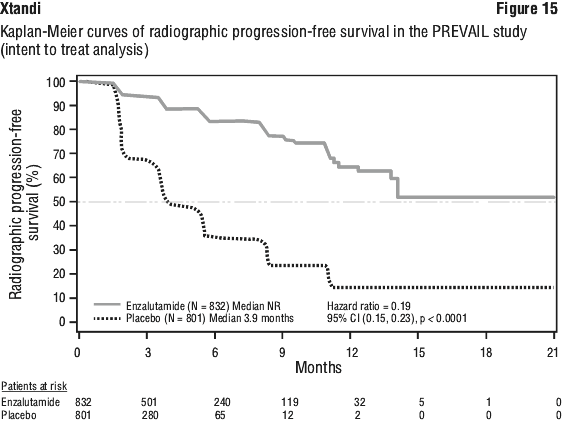 At the time of the primary analysis there were 1633 patients randomised.
At the time of the primary analysis there were 1633 patients randomised.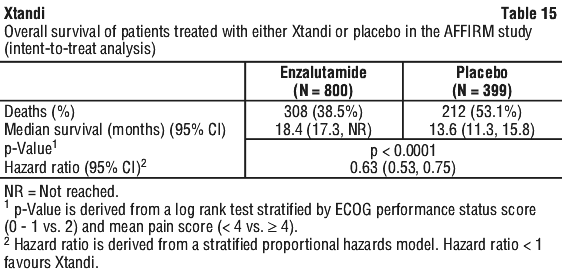
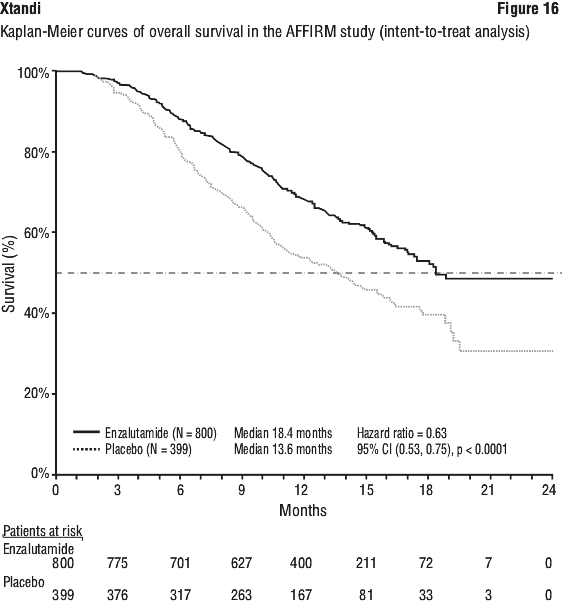
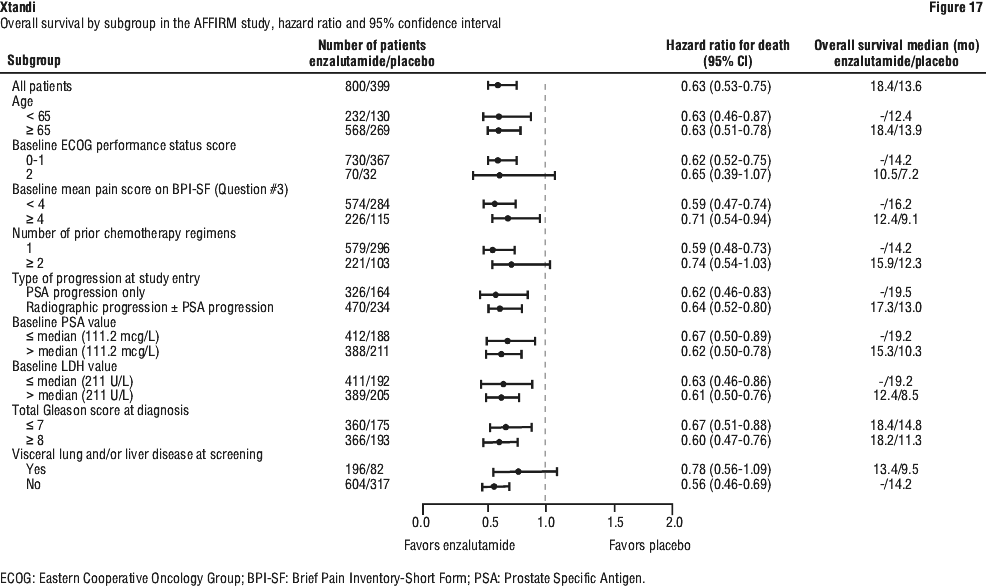 In addition to the observed improvement in overall survival, key secondary endpoints (radiographic progression-free survival, and time to first skeletal-related event) favoured Xtandi and were statistically significant after adjusting for multiple testing.
In addition to the observed improvement in overall survival, key secondary endpoints (radiographic progression-free survival, and time to first skeletal-related event) favoured Xtandi and were statistically significant after adjusting for multiple testing. Chemical name: 4-{3-[4-cyano-3-(trifluoromethyl)phenyl]- 5,5-dimethyl-4-oxo-2-thioxoimidazolidin-1-yl}-2-fluoro- N-methylbenzamide.
Chemical name: 4-{3-[4-cyano-3-(trifluoromethyl)phenyl]- 5,5-dimethyl-4-oxo-2-thioxoimidazolidin-1-yl}-2-fluoro- N-methylbenzamide.